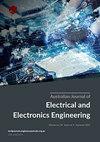基于保密和速率的非法中继选择
Q3 Engineering
Australian Journal of Electrical and Electronics Engineering
Pub Date : 2022-09-16
DOI:10.1080/1448837X.2022.2112930
引用次数: 1
摘要
研究了双向中继辅助网络中基于和速率的非法中继选择策略的保密性能。在系统模型中考虑了两跳多路半双工和全双工双向非法中继网络以及有限数量的友好干扰器对非法中继的影响。大量的计算机仿真结果表明,基于保密和速率的全双工非法中继选择策略在中断性能方面优于半双工策略。仿真结果还表明,基于保密和速率的中继选择策略比基于最大最小选择算法具有更好的保密性能。性能结果还表明,基于保密最大最小和和率的选择策略在高信噪比下实现了与合法终端和非法终端之间的路径数相等的合作分集顺序。此外,结果表明,在半双工和全双工模式下,基于保密和速率的选择比基于最大最小值的选择提供了更好的吞吐量性能。最后,研究结果表明,在远离非法中继终端的情况下,大量友好干扰机不会严重影响系统的保密性能。本文章由计算机程序翻译,如有差异,请以英文原文为准。
Secrecy sum-rate based illegitimate relay selection
ABSTRACT This study presents the secrecy performance of sum-rate-based illegitimate relay selection policy for the two-way relay-assisted network. Two-hop multiple half- and full-duplex two-way illegitimate relay network and a limited number of friendly jammers, affecting to the illegitimate relays, are considered in the system model. Extensive computer simulation results reveal that the secrecy sum-rate-based full-duplex illegitimate relay selection policy outperforms the half-duplex-based counterpart in terms of outage performance. Simulation results also show that the secrecy sum-rate-based relay selection policy provides a better secrecy performance than the max-min-based selection algorithm. The obtained performance results also show that secrecy max-min- and sum-rate-based selection strategies achieve a cooperative diversity order, equal to the number of paths between legitimate and illegitimate terminals, in high signal-to-noise ratios. Also, results indicate that secrecy sum-rate-based selection provides better throughput performance than the max-min-based alternative for half-duplex and full-duplex modes. Finally, results show that a large number of friendly jammers do not severely affect the system secrecy performance if they are located relatively far from the illegitimate relay terminal.
求助全文
通过发布文献求助,成功后即可免费获取论文全文。
去求助
来源期刊

Australian Journal of Electrical and Electronics Engineering
Engineering-Electrical and Electronic Engineering
CiteScore
2.30
自引率
0.00%
发文量
46
期刊介绍:
Engineers Australia journal and conference papers.
 求助内容:
求助内容: 应助结果提醒方式:
应助结果提醒方式:


